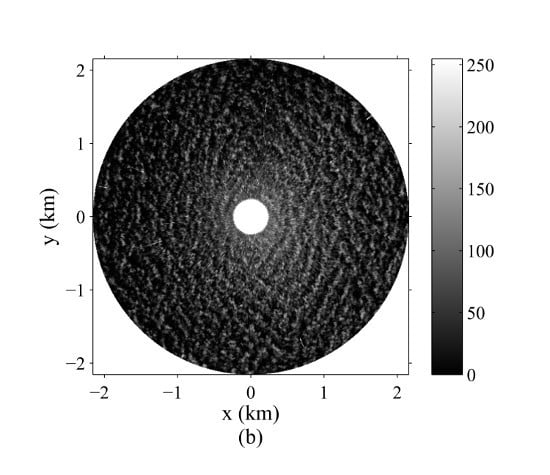Ocean Wind and Wave Measurements Using X-Band Marine Radar: A Comprehensive Review
Abstract
:1. Introduction
2. Wind Measurements
2.1. Wind-Streaks-Based Techniques
2.1.1. Local Gradients Method and Neural Network
2.1.2. Optical Flow-Based Motion Estimation
2.2. Intensity-Variation-Over-Azimuth-Based Techniques
2.2.1. Curve Fitting (CF)-Based Methods
A. Single-CF
B. Dual-CF
C. Two-Model-CF
2.2.2. Intensity Level Selection (ILS)-Based Methods
A. Original ILS
B. Modified ILS
C. Texture-Analysis-Incorporated
2.2.3. Probability Distribution Function
2.3. Spectral-Analysis-Based Techniques
2.3.1. Background Noise
2.3.2. 1D Spectral Analysis
2.3.3. Ensemble Empirical Mode Decomposition-Based Algorithms
A. 1D- and 2D-EEMD
B. EEMD-Normalization
2.4. Summary
3. Wave Measurements
3.1. Spectral-Analysis-Based Techniques
3.1.1. 3D-DFT-Based Algorithms
A. Traditional Algorithm
B. Multilayer Perceptrons
C. Iterative Least-Squares
D. New MTFs
E. Adaptive Recursive Positioning
F. Geometrics-Based SNR Estimation
3.1.2. 2D Continuous Wavelet Transform-Based Algorithms
A. Original Algorithm
B. Self-Adaptive 2D-CWT
3.1.3. Array Beamforming Algorithm
3.2. Texture-Analysis-Based Techniques
3.2.1. Illumination Probability
3.2.2. Statistical Analysis
3.2.3. Tilt-Based Algorithm
3.2.4. Shadowing-Based Algorithms
A. Original Algorithm
B. Modified Algorithm
C. Water-Depth-Incorporated Algorithm
3.2.5. Support Vector Regression Algorithm
3.2.6. Empirical Orthogonal Function-Based Algorithms
A. Principal component
B. Rotated EOF
C. Joint PDF
3.2.7. EEMD-Based Algorithm
3.3. Coherent Radar
3.4. Summary
4. Conclusions and Outlook
Acknowledgments
Author Contributions
Conflicts of Interest
Abbreviations
| SAR | Synthetic Aperture Radar |
| HF | High Frequency |
| HH | Horizontal-Transmit-Horizontal-Receive |
| RCS | Radar Cross Section |
| LGM | Local Gradients Method |
| NN | Neural Network |
| NRCS | Normalized Radar Cross Section |
| CCF | Cross-Correlation Function |
| CS | Cross-Spectrum |
| OFM | Optical Flow Motion Estimation-Based Technique |
| CF | Curve Fitting |
| RMS | Root-Mean-Square |
| ZPP | Zero-Pixel Percentage |
| ILS | Intensity Level Selection |
| FOV | Field of View |
| TAI | Texture-Analysis-Incorporated |
| Probability Distribution Function | |
| BGN | Background Noise |
| DFT | Discrete Fourier Transform |
| SA | Spectral Analysis |
| EEMD | Ensemble Empirical Mode Decomposition |
| IMF | Intrinsic Mode Function |
| HCD | High-Clutter Direction |
| HCDP | High-Clutter Direction Percentage |
| HPP | High-Pixel Percentage |
| AM | Amplitude Modulation |
| FM | Frequency Modulation |
| MTF | Modulation Transfer Function |
| SNR | Signal-to-Noise Ratio |
| FPSO | Floating Production and Storage Offshore |
| VV | Vertical-Transmit-Vertical-Receive |
| ANN | Artificial Neural Network |
| MLP | Multilayer Perceptrons |
| LS | Least-Squares |
| ARPM | Adaptive Recursive Positioning Method |
| CWT | Continuous Wavelet Transform |
| ApFFT | All-Phased Fast Fourier Transform |
| GFC | Gullfaks C |
| CSR | Cartesian Start Range |
| GLCM | Gray Level Co-Occurrence Matrix |
| SVR | Support Vector Regression |
| MAE | Mean Absolute Error |
| MSE | Mean Square Error |
| EOF | Empirical Orthogonal Function |
| PC | Principal Component |
| MEM | Maximum Entropy Method |
| PSD | Power Spectral Density |
| REOF | Rotated Empirical Orthogonal Function |
References
- Moat, B.I.; Yelland, M.J.; Pascal, R.W.; Molland, A.F. The effect of ship shape and anemometer location on wind speed measurements obtained from ships. In Proceedings of the International Conference on Marine Computational Fluid Dynamics, Southampton, UK, 30–31 March 2005. [Google Scholar]
- Hessner, K.G.; Nieto-Borge, J.C.; Bell, P.S. Nautical radar measurements in Europe: Applications of WaMoS II as a sensor for sea state, current and bathymetry. In Remote Sensing of the European Seas; Barale, V., Gade, M., Eds.; Springer: Dordrecht, The Netherlands, 2008; pp. 435–446. [Google Scholar]
- Engen, G.; Johnsen, H. SAR-ocean wave inversion using image cross spectra. IEEE Trans. Geosci. Remote Sens. 1995, 33, 1047–1056. [Google Scholar] [CrossRef]
- Lehner, S.; Schulz-Stellenfleth, J.; Schattler, B.; Breit, H.; Horstmann, J. Wind and wave measurements using complex ERS-2 SAR wave mode data. IEEE Trans. Geosci. Remote Sens. 2000, 38, 2246–2257. [Google Scholar] [CrossRef]
- Lin, H.; Xu, Q.; Zheng, Q. An overview on SAR measurements of sea surface wind. Progr. Nat. Sci. 2008, 18, 913–919. [Google Scholar] [CrossRef]
- Lipa, B.J.; Barrick, D.E.; Isaacson, J.; Lill, P.M. CODAR wave measurements from a North Sea semisubmersible. IEEE J. Ocean. Eng. 1990, 15, 119–125. [Google Scholar] [CrossRef]
- Huang, W.; Wu, S.; Gill, E.W.; Wen, B.; Hou, J. HF radar wave and wind measurement over the Eastern China Sea. IEEE Trans. Geosci. Remote Sens. 2002, 40, 1950–1955. [Google Scholar] [CrossRef]
- Wyatt, L.R.; Green, J.J.; Middleditch, A.; Moorhead, M.D.; Howarth, J.; Holt, M.; Keogh, S. Operational wave, current, and wind measurements with the Pisces HF radar. IEEE J. Ocean. Eng. 2006, 31, 819–834. [Google Scholar] [CrossRef]
- Young, I.R.; Rosenthal, W.; Ziemer, F. A three-dimensional analysis of marine radar images for the determination of ocean wave directionality and surface currents. J. Geophys. Res. 1985, 90, 1049–1059. [Google Scholar] [CrossRef]
- Nieto-Borge, J.C.; Reichert, K.; Dittmer, J. Use of nautical radar as a wave monitoring instrument. Coast. Eng. 1999, 37, 331–342. [Google Scholar] [CrossRef]
- Huang, W.; Gill, E.W. Ocean remote sensing using X-band shipborne nautical radar—Applications in eastern Canada. In Coastal Ocean Observing Systems; Liu, Y., Kerkering, H., Weisberg, R.H., Eds.; Academic Press: London, UK, 2015; pp. 248–264. [Google Scholar]
- Horstmann, J.; Nieto-Borge, J.C.; Seemann, J.; Carrasco, R.; Lund, B. Wind, wave, and current retrieval utilizing X-band marine radars. In Coastal Ocean Observing Systems; Liu, Y., Kerkering, H., Weisberg, R.H., Eds.; Academic Press: London, UK, 2015; pp. 281–304. [Google Scholar]
- Lyzenga, D.R.; Maffett, A.L.; Shuchman, R.A. The contribution of wedge scattering to the radar cross section of the ocean surface. IEEE Trans. Geosci. Remote Sens. 1983, GE-21, 502–505. [Google Scholar] [CrossRef]
- Wetzel, L.B. Electromagnetic scattering from the sea at low grazing angles. In Surface Waves and Fluxes: Volume II—Remote Sensing; Geernaert, G.L., Plant, W.L., Eds.; Springer: Dordrecht, The Netherlands, 1990; pp. 109–171. [Google Scholar]
- Lee, P.H.Y.; Barter, J.D.; Caponi, E.; Caponi, M.; Hindman, C.L.; Lake, B.M.; Rungaldier, H. Wind-speed dependence of small-grazing-angle microwave backscatter from sea surfaces. IEEE Trans. Antennas Propag. 1996, 44, 333–340. [Google Scholar] [CrossRef]
- Trizna, D.B.; Carlson, D.J. Studies of dual polarized low grazing angle radar sea scatter in nearshore regions. IEEE Trans. Geosci. Remote Sens. 1996, 34, 747–757. [Google Scholar] [CrossRef]
- Nieto-Borge, J.C.; Rodriguez, G.; Hessner, K.; Izquierdo, P. Inversion of marine radar images for surface wave analysis. J. Atmos. Ocean. Technol. 2004, 21, 1291–1300. [Google Scholar] [CrossRef]
- Nieto-Borge, J.C.; Guedes, C. Analysis of directional wave fields using X-band navigation radar. Coast. Eng. 2000, 40, 375–391. [Google Scholar] [CrossRef]
- Izquierdo, P.; Guedes-Soares, C.; Nieto-Borge, J.C.; Rodriguez, G.R. A comparison of sea-state parameters from nautical radar images and buoy data. Ocean Eng. 2004, 31, 2209–2225. [Google Scholar] [CrossRef]
- Cui, L.; He, Y.; Shen, H.; Lu, H. Measurements of ocean wave and current field using dual polarized X-band radar. Chin. J. Oceanol. Limnol. 2010, 28, 1021–1028. [Google Scholar] [CrossRef]
- Vivone, G.; Braca, P. Joint probabilistic data association tracker for extended target tracking applied to X-band marine radar data. IEEE J. Ocean. Eng. 2016, 41, 1007–1019. [Google Scholar] [CrossRef]
- Zhu, X.; Li, Y.; Feng, H.; Liu, B.; Xu, J. Oil spill detection method using X-band marine radar imagery. J. Appl. Remote Sens. 2015, 9, 095958. [Google Scholar] [CrossRef]
- Lund, B.; Graber, H.C.; Xue, J.; Romeiser, R. Analysis of internal wave signatures in marine radar data. IEEE Trans. Geosci. Remote Sens. 2013, 51, 4840–4852. [Google Scholar] [CrossRef]
- Dankert, H.; Horstmann, J.; Lehner, S.; Rosenthal, W. Detection of wave groups in SAR images and radar image sequences. IEEE Trans. Geosci. Remote Sens. 2003, 41, 1437–1446. [Google Scholar] [CrossRef]
- Senet, C.M.; Seemann, J.; Ziemer, F. The near-surface current velocity determined from image sequences of the sea surface. IEEE Trans. Geosci. Remote Sens. 2001, 39, 492–505. [Google Scholar] [CrossRef]
- Hessner, K.; Bell, P.S. High resolution current & bathymetry determined by nautical X-band radar in shallow waters. In Proceedings of the MTS/IEEE Oceans Conference, Bremen, Germany, 11–14 May 2009. [Google Scholar]
- Serafino, F.; Lugni, C.; Soldovieri, F. A novel strategy for the surface current determination from marine X-band radar data. IEEE Geosci. Remote Sens. Lett. 2010, 7, 231–235. [Google Scholar] [CrossRef]
- Huang, W.; Carrasco, R.; Shen, C.; Gill, E.W.; Horstmann, J. Surface current measurements using X-band marine radar with vertical polarization. IEEE Trans. Geosci. Remote Sens. 2010, 7, 231–235. [Google Scholar] [CrossRef]
- Raffa, F.; Ludeno, G.; Patti, B.; Soldovieri, F.; Mazzola, S.; Serafina, F. X-band wave radar for coastal upwelling detection off the southern coast of Sicily. J. Atmos. Ocean. Technol. 2017, 34, 21–31. [Google Scholar] [CrossRef]
- Chen, Z.; Pan, J.; He, Y.; Devlin, A.T. Estimate of tidal constituents in nearshore waters using X-band marine radar image sequences. IEEE Trans. Geosci. Remote Sens. 2016, 54, 6700–6711. [Google Scholar] [CrossRef]
- Bell, P.S.; Osler, J.C. Mapping bathymetry using X-band marine radar data recorded from a moving vessel. Ocean Dyn. 2011, 61, 2141–2156. [Google Scholar] [CrossRef]
- Wu, L.C.; Doong, D.J.; Wang, J.H. Bathymetry determination from marine radar image sequences using the Hilbert transform. IEEE Geosci. Remote Sens. Lett. 2017, 14, 644–648. [Google Scholar] [CrossRef]
- Greenwood, C.E.; Morrison, J.; Murray, A.; Vogler, A. A method for approximating surface elevation from a shore mounted X-band radar with a low grazing angle. In Proceedings of the Twenty-Seventh International Ocean and Polar Engineering Conference, San Francisco, CA, USA, 25–30 June 2017. [Google Scholar]
- Greenwood, C.E.; Vogler, A.; Morrison, J.; Murray, A. The approximation of a sea surface using a shore mounted X-band radar with low grazing angle. Remote Sens. Environ. 2018, 204, 439–447. [Google Scholar] [CrossRef]
- Hilmer, T.; Thornhill, E. Deterministic wave predictions from the WaMoS II. In Proceedings of the MTS/IEEE Oceans Conference, Taipei, Taiwan, 7–10 April 2014. [Google Scholar]
- Hilmer, T.; Thornhill, E. Observations of predictive skill for real-time deterministic sea waves from the WaMoS II. In Proceedings of the MTS/IEEE Oceans Conference, Washington, DC, USA, 19–22 October 2015. [Google Scholar]
- Punzo, M.; Lanciano, C.; Tarallo, D.; Bianco, F.; Cavuoto, G.; De Rosa, R.; Di Fiore, V.; Cianflone, G.; Dominici, R.; Iavarone, M.; et al. Application of X-band wave radar for coastal dynamic analysis: Case test of Bagnara Calabra (South Tyrrhenian Sea, Italy). J. Sens. 2016, 2016. [Google Scholar] [CrossRef]
- McCann, D.L.; Bell, P.S. Observations and tracking of killer whales (Orcinus orca) with shore-based X-band marine radar at a marine energy test site. Mar. Mammal Sci. 2017, 33, 904–912. [Google Scholar] [CrossRef]
- Hatten, H.; Seemann, J.; Horstmann, J.; Ziemer, F. Azimuthal dependence of the radar cross section and the spectral background noise of a nautical radar at grazing incidence. In Proceedings of the IEEE International Geoscience and Remote Sensing Symposium, Seattle, WA, USA, 6–10 July 1998. [Google Scholar]
- Horstmann, J.; Koch, W.; Lehner, S.; Tonboe, R. Ocean winds from RADARSAT-1 ScanSAR. Can. J. Remote Sens. 2002, 28, 524–533. [Google Scholar] [CrossRef]
- Koch, W. Directional analysis of SAR images aiming at wind direction. IEEE Trans. Geosci. Remote Sens. 2004, 42, 702–710. [Google Scholar] [CrossRef]
- Dankert, H.; Horstmann, J.; Rosenthal, W. Ocean wind fields retrieved from radar-image sequences. J. Geophys. Res. Oceans 2003, 108, 3353–3362. [Google Scholar] [CrossRef]
- Dankert, H.; Horstmann, J.; Rosenthal, W. Wind- and wave-field measurements using marine X-band radar-image sequences. IEEE J. Ocean. Eng. 2005, 30, 534–542. [Google Scholar] [CrossRef]
- Dankert, H.; Horstmann, J. A marine radar wind sensor. J. Atmos. Ocean. Technol. 2007, 24, 1629–1642. [Google Scholar] [CrossRef]
- Dankert, H.; Horstmann, J.; Rosenthal, W. Ocean surface winds retrieved from marine radar-image sequences. In Proceedings of the IEEE International Geoscience and Remote Sensing Symposium, Anchorage, AK, USA, 20–24 September 2004. [Google Scholar]
- Haußecker, H.; Spies, H. Motion. In Handbook of Computer Vision and Applications: Volume 2 Signal Processing and Pattern Recognition; Ja¨hne, B., Haußecker, H., Geißler, P., Eds.; Academic Press: San Diego, CA, USA, 1999; pp. 309–396. [Google Scholar]
- Lund, B.; Graber, H.C.; Romeiser, R. Wind retrieval from shipborne nautical X-band radar data. IEEE Trans. Geosci. Remote Sens. 2012, 50, 3800–3811. [Google Scholar] [CrossRef]
- Liu, Y.; Huang, W.; Gill, E.W.; Peters, D.K.; Vicen-Bueno, R. Comparison of algorithms for wind parameters extraction from shipborne X-band marine radar images. IEEE J. Sel. Top. Appl. Earth Obs. Remote Sens. 2015, 8, 896–906. [Google Scholar] [CrossRef]
- Vicen-Bueno, R.; Horstmann, J.; Terril, E.; De Paolo, T.; Dannenberg, J. Real-time ocean wind vector retrieval from marine radar image sequences acquired at grazing angle. J. Atmos. Ocean. Technol. 2013, 30, 127–139. [Google Scholar] [CrossRef]
- Huang, W.; Liu, Y.; Gill, E.W. Texture-analysis-incorporated wind parameters extraction from rain-contaminated X-band nautical radar images. Remote Sens. 2017, 9, 166. [Google Scholar] [CrossRef]
- Chen, Z.; He, Y.; Zhang, B.; Qiu, Z. Determination of nearshore sea surface wind vector from marine X-band radar images. Ocean Eng. 2015, 96, 79–85. [Google Scholar] [CrossRef]
- Izquierdo, P.; Soares, C.G. Analysis of sea waves and wind from x-band radar. Ocean Eng. 2005, 32, 1404–1419. [Google Scholar] [CrossRef]
- Wang, Y.; Huang, W. An algorithm for wind direction retrieval from X-band marine radar images. IEEE Geosci. Remote Sens. Lett. 2016, 13, 252–256. [Google Scholar] [CrossRef]
- Huang, W.; Wang, Y. A spectra-analysis-based algorithm for wind speed estimation from X-band nautical radar images. IEEE Geosci. Remote Sens. Lett. 2016, 13, 701–705. [Google Scholar] [CrossRef]
- Liu, X.; Huang, W.; Gill, E.W. Wind direction estimation from rain-contaminated marine radar data using the ensemble empirical mode decomposition method. IEEE Trans. Geosci. Remote Sens. 2017, 55, 1833–1841. [Google Scholar] [CrossRef]
- Wu, Z.; Huang, N.E. Ensemble empirical mode decomposition: A noise-assisted data analysis method. Adv. Adapt. Data Anal. 2009, 1, 1–41. [Google Scholar] [CrossRef]
- Wu, Z.; Huang, N.E.; Chen, X. The multi-dimensional ensemble empirical mode decomposition method. Adv. Adapt. Data Anal. 2009, 1, 339–372. [Google Scholar] [CrossRef]
- Huang, W.; Liu, X.; Gill, E.W. An empirical mode decomposition method for sea surface wind measurements from X-band nautical radar data. IEEE Trans. Geosci. Remote Sens. 2017, 55, 6218–6227. [Google Scholar] [CrossRef]
- Huang, N.E.; Wu, Z.; Long, S.R.; Arnold, K.C.; Chen, X.; Blank, K. On instantaneous frequency. Adv. Adapt. Data Anal. 2009, 1, 177–229. [Google Scholar] [CrossRef]
- Alpers, W.; Hasselmann, K. Spectral signal to clutter and thermal noise properties of ocean wave imaging synthetic aperture radars. Int. J. Remote Sens. 1982, 3, 423–446. [Google Scholar] [CrossRef]
- Nieto-Borge, J.C.; Hessner, K.; Jarabo-Amores, P.; de la Mata-Moya, D. Signal-to-noise ratio analysis to estimate ocean wave heights from X-band marine radar image time series. IET Radar Sonar Navig. 2008, 2, 35–41. [Google Scholar] [CrossRef]
- Ziemer, F.; Dittmer, J. A system to monitor ocean wave fields. In Proceedings of the MTS/IEEE Oceans Conference, Brest, France, 13–16 September 1994. [Google Scholar]
- Nieto-Borge, J.C.; Hessner, K.; Reichert, K. Estimation of the significant wave height with X-band nautical radars. In Proceedings of the 18th International Conference on Offshore Mechanics and Arctic Engineering, St. John‘s, NL, Canada, 11–16 July 1999. [Google Scholar]
- Thornhill, E.M.; Stredulinsky, D.C. Real time local sea state measurement using wave radar and ship motions. Trans. SNAME 2010, 118, 248–259. [Google Scholar]
- Stredulinsky, D.C.; Thornhill, E.M. Ship motion and wave radar data fusion for shipboard wave measurement. J. Ship Res. 2011, 55, 73–85. [Google Scholar]
- Lund, B.; Collins, C.O.; Graber, H.C.; Terrill, E.; Herbers, T.H.C. Marine radar ocean wave retrieval’s dependency on range and azimuth. Ocean Dyn. 2014, 64, 999–1018. [Google Scholar] [CrossRef]
- Vicen-Bueno, R.; Lido-Muela, C.; Nieto-Borge, J.C. Estimate of significant wave height from non-coherent marine radar images by multilayer perceptrons. EURASIP J. Adv. Signal Process. 2012, 2012, 1–20. [Google Scholar] [CrossRef]
- Huang, W.; Gill, E.W.; An, J. Iterative least-squares-based wave measurement using X-band nautical radar. IET Radar Sonar Navig. 2014, 8, 853–863. [Google Scholar] [CrossRef]
- Huang, W.; Gill, E.W. Surface current measurement under low sea state using dual polarized X-band nautical radar. IEEE J. Sel. Top. Appl. Earth Obs. Remote Sens. 2012, 5, 1868–1873. [Google Scholar] [CrossRef]
- Chen, Z.; Zhang, B.; He, Y.; Qiu, Z.; William, P. A new modulation transfer function for ocean wave spectra retrieval from X-band marine radar imagery. Chin. J. Oceanol. Limnol. 2015, 33, 1132–1141. [Google Scholar] [CrossRef]
- Qiu, J.; Zhang, B.; Chen, Z.; He, Y. A new modulation transfer function with range and azimuth dependence for ocean wave spectra retrieval from X-band marine radar observations. IEEE Geosci. Remote Sens. Lett. 2017, 14, 1373–1377. [Google Scholar] [CrossRef]
- WaMoS II Wave and Surface Current Monitoring System Operating Manual Version 4; OceanWaves GmbH: Luneburg, Germany, 2012.
- Al-Habashneh, A.; Moloney, C.; Gill, E.W.; Huang, W. An adaptive method of wave spectrum estimation using X-band nautical radar. Remote Sens. 2015, 7, 16537–16554. [Google Scholar] [CrossRef]
- Wang, L.; Wu, X.; Yue, X.; Ma, K.; Tian, Y. A novel algorithm in estimating signal-to-noise ratio for ocean wave height inversion from X-band radar images. IEEE Geosci. Remote Sens. Lett. 2016, 13, 344–348. [Google Scholar] [CrossRef]
- Wang, L.; Wu, X.; Ma, K.; Tian, Y.; Fei, Y. Elimination of the impact of vessels on ocean wave height inversion with X-band wave monitoring radar. Chin. J. Oceanol. Limnol. 2016, 34, 1114–1121. [Google Scholar] [CrossRef]
- Chuang, L.Z.H.; Wu, L.C.; Doong, D.J.; Kao, C.C. Two-dimensional continuous wavelet transform of simulated spatial images of waves on a slowly varying topography. Ocean Eng. 2008, 35, 1039–1051. [Google Scholar] [CrossRef]
- Wu, L.C.; Chuang, L.Z.H.; Doong, D.J.; Kao, C.C. Ocean remotely sensed image analysis using two-dimensional continuous wavelet transform. Int. J. Remote Sens. 2011, 32, 1039–1051. [Google Scholar] [CrossRef]
- Antoine, J.P.; Murenzi, R.; Vandergheynst, P.; Ali, S.T. Two Dimensional Wavelets and Their Relatives; Cambridge University Press: Cambridge, UK, 2004. [Google Scholar]
- An, J.; Huang, W.; Gill, E.W. 2-D continuous wavelet based algorithm for extracting wave information from nautical radar images. In Proceedings of the IEEE Radar Conference, Ottawa, ON, Canada, 29 April–3 May 2013. [Google Scholar]
- An, J.; Huang, W.; Gill, E.W. A self-adaptive wavelet-based algorithm for wave measurement using nautical radar. IEEE Trans. Geosci. Remote Sens. 2015, 53, 567–577. [Google Scholar]
- Ma, K.; Wu, X.; Yue, X.; Wang, L.; Liu, J. Array beamforming algorithm for estimating waves and currents from marine X-band radar image sequences. IEEE Trans. Geosci. Remote Sens. 2017, 55, 1262–1272. [Google Scholar] [CrossRef]
- Van Veen, B.D.; Buckley, K.M. Beamforming: A versatile approach to spatial filtering. IEEE ASSP Mag. 1998, 5, 4–24. [Google Scholar] [CrossRef]
- Huang, X.; Wang, Z.; Hou, G. New method of estimation of phase, amplitude, and frequency based on all phase FFT spectrum analysis. In Proceedings of the International Symposium on Intelligent Signal Processing and Communication Systems, Xiamen, China, 28 November–1 December 2007. [Google Scholar]
- Henschel, M.D.; Buckley, J.R.; Dobson, F.W. Estimates of wave height from low incidence angle sea clutter. In Proceedings of the ICWHF, Banff, AB, Canada, 16–20 October 1995. [Google Scholar]
- Buckley, J.R.; Aler, J. Estimation of ocean wave height from grazing incidence microwave backscatter. In Proceedings of the IEEE International Geoscience and Remote Sensing Symposium, Seattle, WA, USA, 6–10 July 1998. [Google Scholar]
- Buckley, J.R.; Aler, J. Enhancements in the determination of ocean surface wave height from grazing incidence microwave backscatter. In Proceedings of the IEEE International Geoscience and Remote Sensing Symposium, Seattle, WA, USA, 6–10 July 1998. [Google Scholar]
- Gangeskar, R. An algorithm for estimation of wave height from shadowing in X-band radar sea surface images. IEEE Trans. Geosci. Remote Sens. 2014, 52, 3373–3381. [Google Scholar] [CrossRef]
- Gangeskar, R. Wave height derived by texture analysis of X-band radar sea surface images. In Proceedings of the IEEE International Geoscience and Remote Sensing Symposium, Honolulu, HI, USA, 24–28 July 1998. [Google Scholar]
- Gangeskar, R. An adaptive method for estimation of wave height based on statistics of sea surface images. In Proceedings of the IEEE International Geoscience and Remote Sensing Symposium, Honolulu, HI, USA, 24–28 July 1998. [Google Scholar]
- Dankert, H.; Rosenthal, W. Ocean surface determination from X-band radar-image sequences. J. Geophys. Res. Oceans 2004, 109, C04016. [Google Scholar] [CrossRef]
- Liu, X.; Huang, W.; Gill, E.W. Comparison of wave height measurement algorithms for ship-borne X-band nautical radar. Can. J. Remote Sens. 2016, 42, 343–353. [Google Scholar] [CrossRef]
- Pratt, W.K. Digital Image Processing; Wiley: Hoboken, NJ, USA, 1991. [Google Scholar]
- Smith, B.G. Geometric shadowing of a random rough surface. IEEE Trans. Antennas Propag. 1967, 15, 668–671. [Google Scholar] [CrossRef]
- Lagarias, J.C.; Reeds, J.A.; Wright, M.H.; Wright, P.E. Convergence properties of the Nelder-Mead simplex method in low dimensions. SIAMJ. Optim. 1998, 9, 112–147. [Google Scholar] [CrossRef]
- Liu, X.; Huang, W.; Gill, E.W. Wave height estimation from ship-borne X-band nautical radar images. J. Sens. 2016, 2016. [Google Scholar] [CrossRef]
- Wei, Y.; Lu, Z.; Pian, G.; Liu, H. Wave height estimation from shadowing based on the acquired X-band marine radar images in coastal area. Remote Sens. 2017, 9, 859. [Google Scholar]
- Salcedo-Sanz, S.; Nieto-Borge, J.C.; Carro-Calvo, L.; Cuadra, L.; Hessner, K.; Alexandre, E. Significant wave height estimation using SVR algorithms and shadowing information from simulated and real measured X-band radar images of the sea surface. Ocean Eng. 2015, 101, 244–253. [Google Scholar] [CrossRef]
- Smola, A.J.; Scholkopt, B. A tutorial on support vector regression. Stat. Comput. 2004, 14, 199–222. [Google Scholar] [CrossRef]
- Chen, Z.; He, Y.; Zhang, B.; Qiu, Z.; Yin, B. A new algorithm to retrieve wave parameters from marine X-band radar image sequences. IEEE Trans. Geosci. Remote Sens. 2014, 52, 4083–4091. [Google Scholar] [CrossRef]
- Bjo¨rnsson, H.; Venegas, S.A. A Manual for EOF and SVD Analyses of Climatic Data; CCGCR Report 97-1; McGill University: Montreal, QC, Canada, 1997. [Google Scholar]
- Monahan, A.H.; Fyfe, J.C.; Ambaum, M.H.P.; Stephenson, D.B.; North, G.R. Empirical orthogonal functions: The medium is the message. J. Clim. 2009, 22, 6501–6514. [Google Scholar] [CrossRef]
- Mulally, D.; Paik, H.W. Power spectral density estimation simulation using the maximum entropy method. In Proceedings of the 36th Midwest Symposium on Circuits and Systems, Detroit, MI, USA, 16–18 August 1993. [Google Scholar]
- Yu, T.; Xie, W.; Zhang, S. Improved algorithm for estimation of significant wave height from X-band radar image sequences. J. Appl. Remote Sens. 2016, 10, 1–12. [Google Scholar] [CrossRef]
- Zhang, S.; Song, Z.; Li, Y. An advanced inversion algorithm for significant wave height estimation based on random field. Ocean Eng. 2016, 127, 298–304. [Google Scholar] [CrossRef]
- Chen, Z.; He, Y.; Zhang, B. An automatic algorithm to retrieve wave height from X-band marine radar image sequence. IEEE Trans. Geosci. Remote Sens. 2017, 55, 6501–6514. [Google Scholar] [CrossRef]
- Longuet-Higgins, M.S. On the joint distribution of wave periods and amplitudes in a random wave field. Proc. R. Soc. Lond. Ser. A 1983, 389, 241–258. [Google Scholar] [CrossRef]
- Sun, F. The joint distribution of ocean wave periods and ocean wave heights (Chinese). Acta Oceanol. Sin. 1998, 10, 10–15. [Google Scholar]
- Liu, X.; Huang, W.; Gill, E.W. Estimation of significant wave height from X-band marine radar images based on ensemble empirical mode decomposition. IEEE Geosci. Remote Sens. Lett. 2017, 17, 1740–1744. [Google Scholar] [CrossRef]
- Braun, N.; Ziemer, F.; Bezuglov, A.; Cysewski, M.; Schymura, G. Sea-surface current features observed by Doppler radar. IEEE Trans. Geosci. Remote Sens. 2008, 46, 1125–1133. [Google Scholar] [CrossRef]
- Trizna, D.B. Coherent microwave marine radars for deterministic wave profile mapping, decameter-scale coastal current mapping, and ocean wave spectra measurements. In Proceedings of the MTS/IEEE Oceans Conference, Biloxi, MS, USA, 26–29 October 2009. [Google Scholar]
- Lyzenga, D.; Nwogu, O.; Trizna, D.; Hathaway, K. Ocean wave field measurements using X-band Doppler radars at low grazing angles. In Proceedings of the IEEE International Geoscience and Remote Sensing Symposium, Honolulu, HI, USA, 25–30 July 2010. [Google Scholar]
- Hackett, E.E.; Fullerton, A.M.; Merrill, C.F.; Fu, T.C. Comparison of incoherent and coherent wave field measurements using dual-polarized pulse-Doppler X-band radar. IEEE Trans. Geosci. Remote Sens. 2015, 53, 5926–5942. [Google Scholar] [CrossRef]
- Trizna, D.B. Coherent marine radar measurements of ocean wave frequency spectra and near surface currents. In Proceedings of the MTS/IEEE Oceans Conference, Shanghai, China, 10–13 April 2016. [Google Scholar]
- Hwang, P.A.; Sletten, M.A.; Toporkov, J.V. A note on Doppler processing of coherent radar backscatter from the water surface: With application to ocean surface wave measurements. J. Geophys. Res. Oceans 2010, 115, C03026. [Google Scholar] [CrossRef]
- Thompson, D.R.; Jensen, J.R. Synthetic aperture radar interferometry applied to ship-generated internal waves in the 1989 Loch Linnhe Experiment. J. Geophys. Res. 1993, 98, 10259–10269. [Google Scholar] [CrossRef]
- Carrasco, R.; Streßer, M.; Horstmann, J. A simple method for retrieving significant wave height from Dopplerized X-band radar. Ocean Sci. 2017, 13, 95–103. [Google Scholar] [CrossRef]
- Carrasco, R.; Horstmann, J.; Seemann, J. Significant wave height measured by coherent X-band radar. IEEE Trans. Geosci. Remote Sens. 2017, 55, 5355–5365. [Google Scholar] [CrossRef]
- Lyzenga, D.R.; Walker, D.T. A simple model for marine radar images of the ocean surface. IEEE Geosci. Remote Sens. Lett. 2015, 12, 2389–2392. [Google Scholar] [CrossRef]
- Cheng, H.Y.; Chien, H. Implementation of S-band marine radar for surface wave measurement under precipitation. Remote Sens. Environ. 2017, 188, 85–94. [Google Scholar] [CrossRef]
- Xu, F.; Li, X.; Wang, P.; Yang, J.; Pichel, W.G.; Jin, Y.Q. A backscattering model of rainfall over rough sea surface for synthetic aperture radar. IEEE Trans. Geosci. Remote Sens. 2015, 53, 3042–3054. [Google Scholar] [CrossRef]
- Liu, X.; Zheng, Q.; Liu, R.; Sletten, M.A.; Duncan, J.H. A model of radar backscatter of rain-generated stalks on the ocean surface. IEEE Trans. Geosci. Remote Sens. 2017, 55, 767–776. [Google Scholar] [CrossRef]





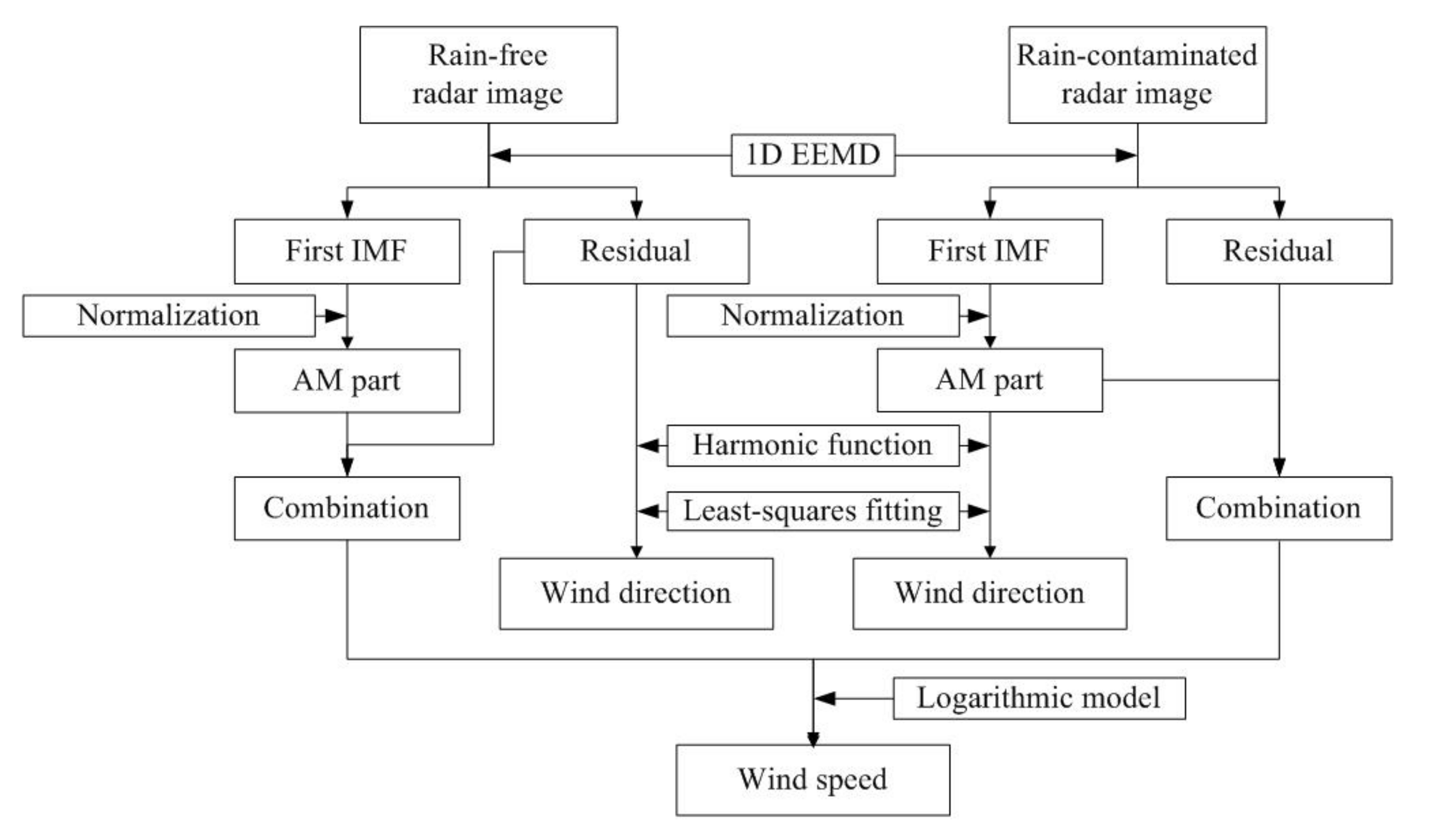
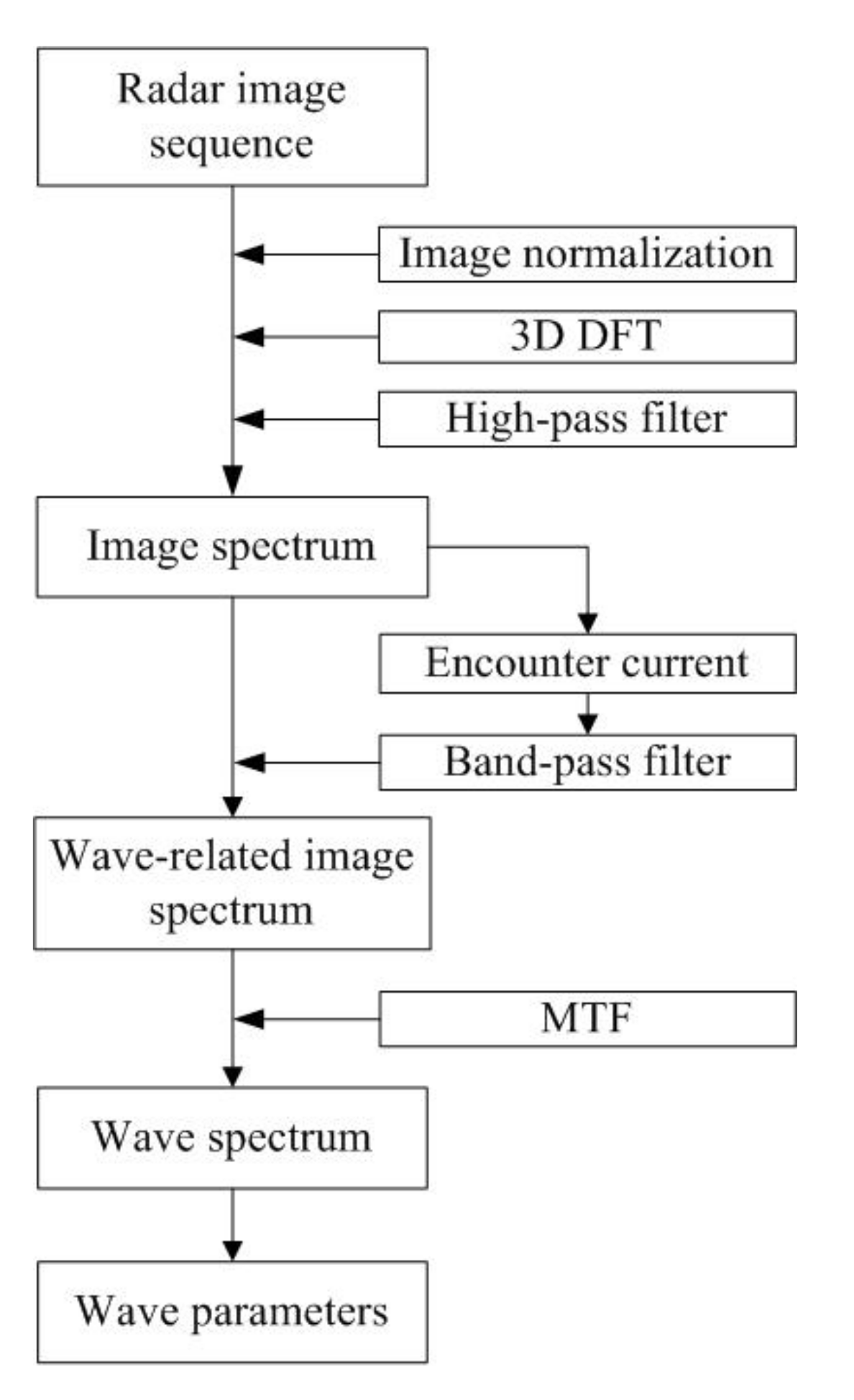
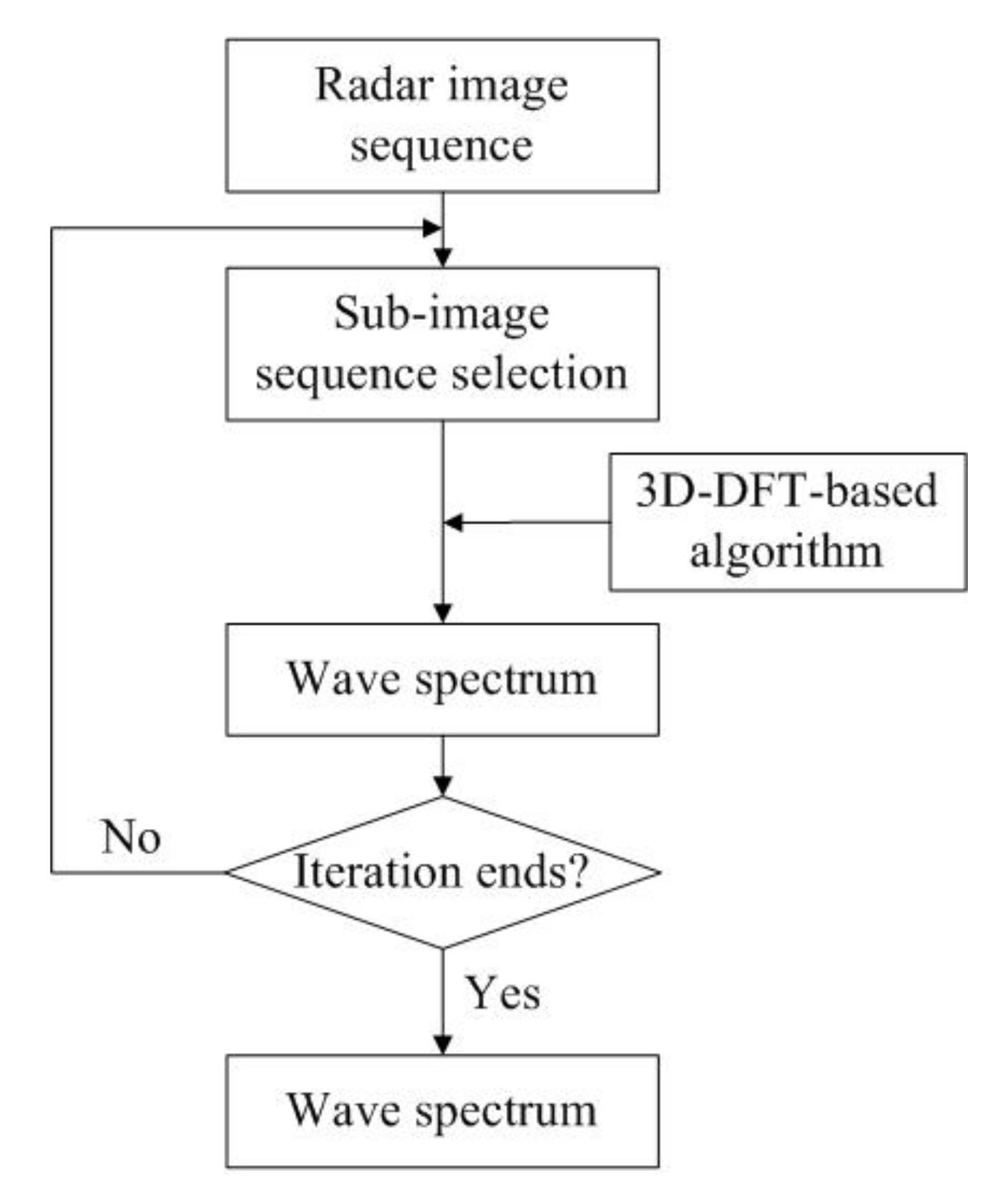
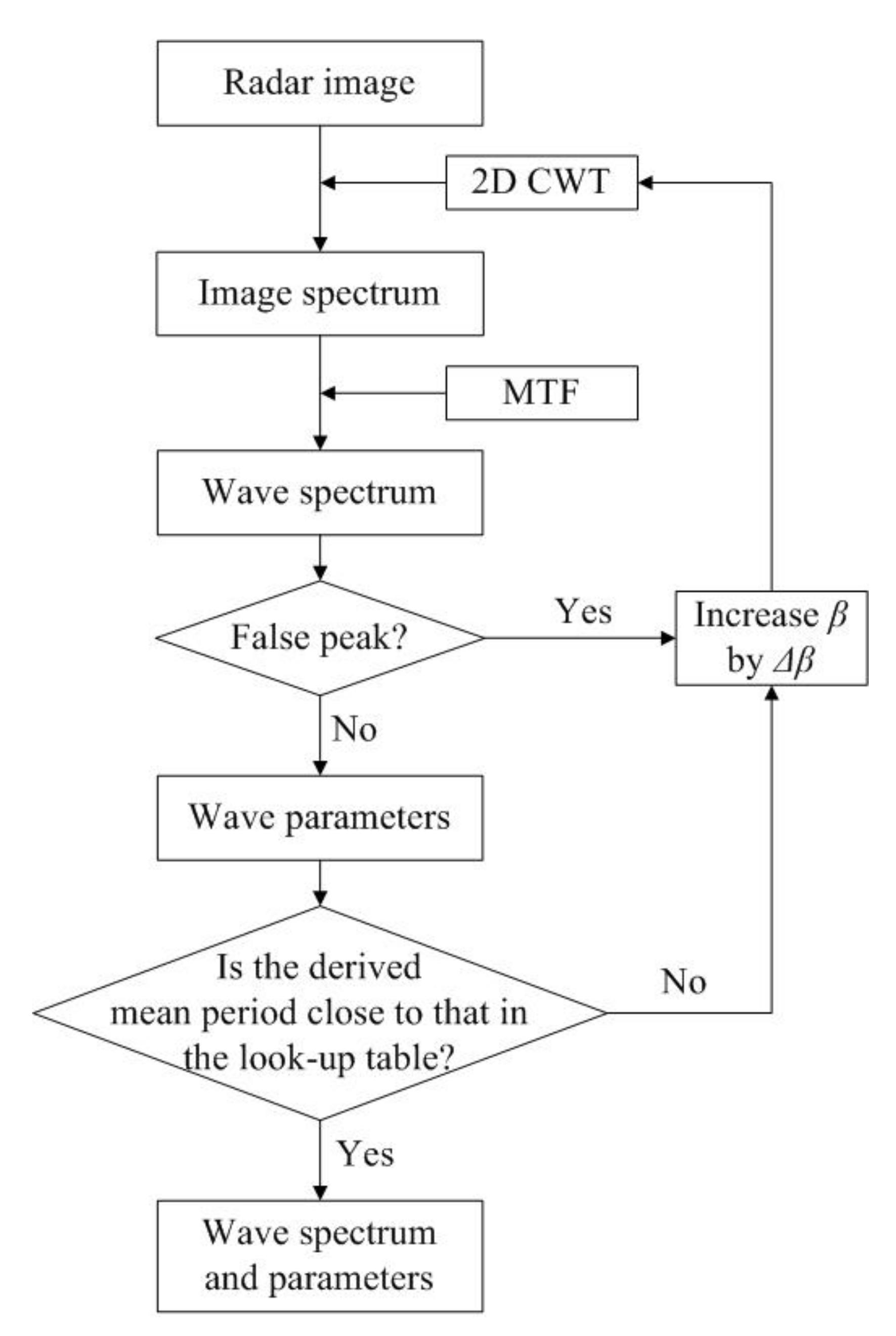
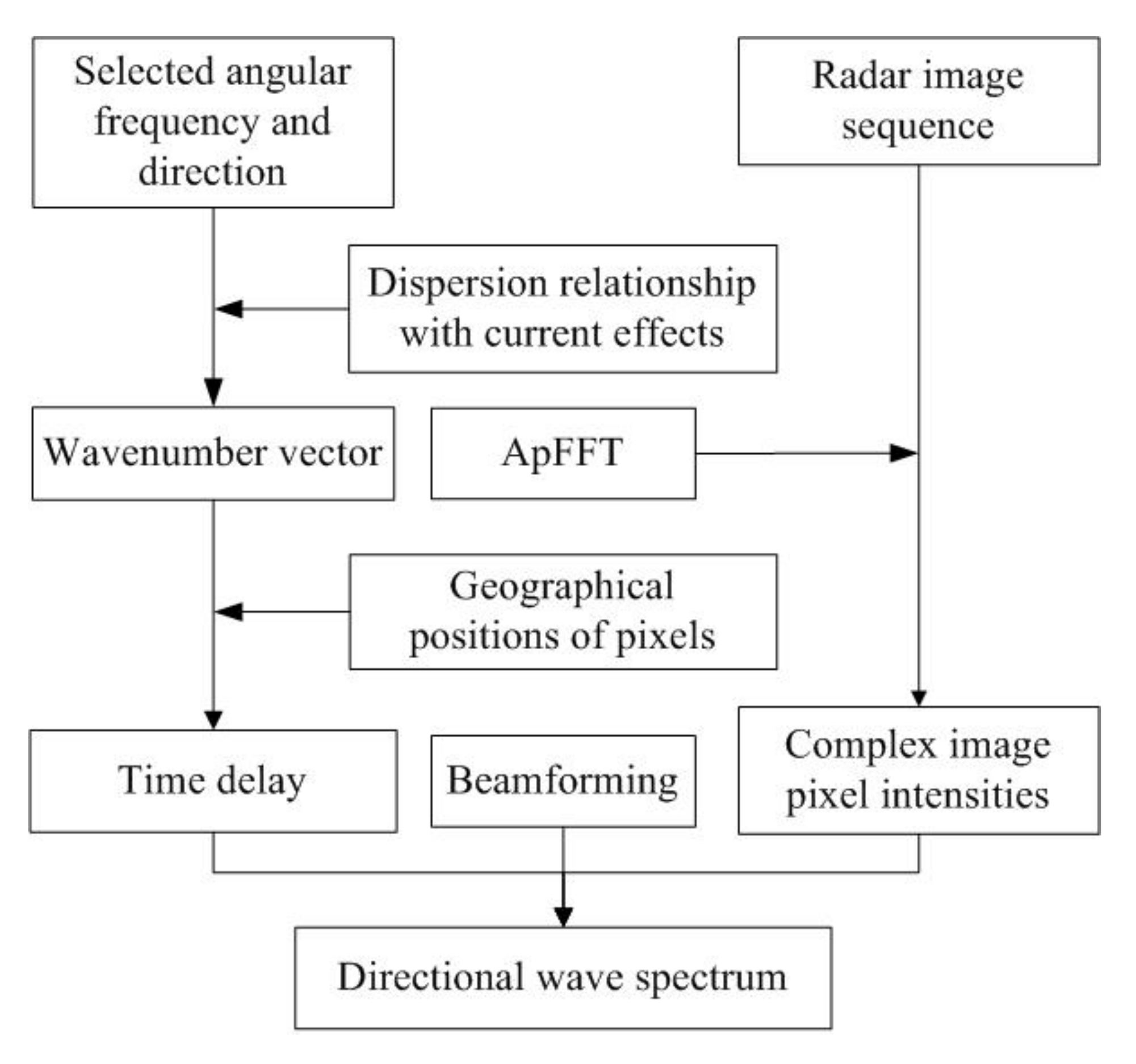
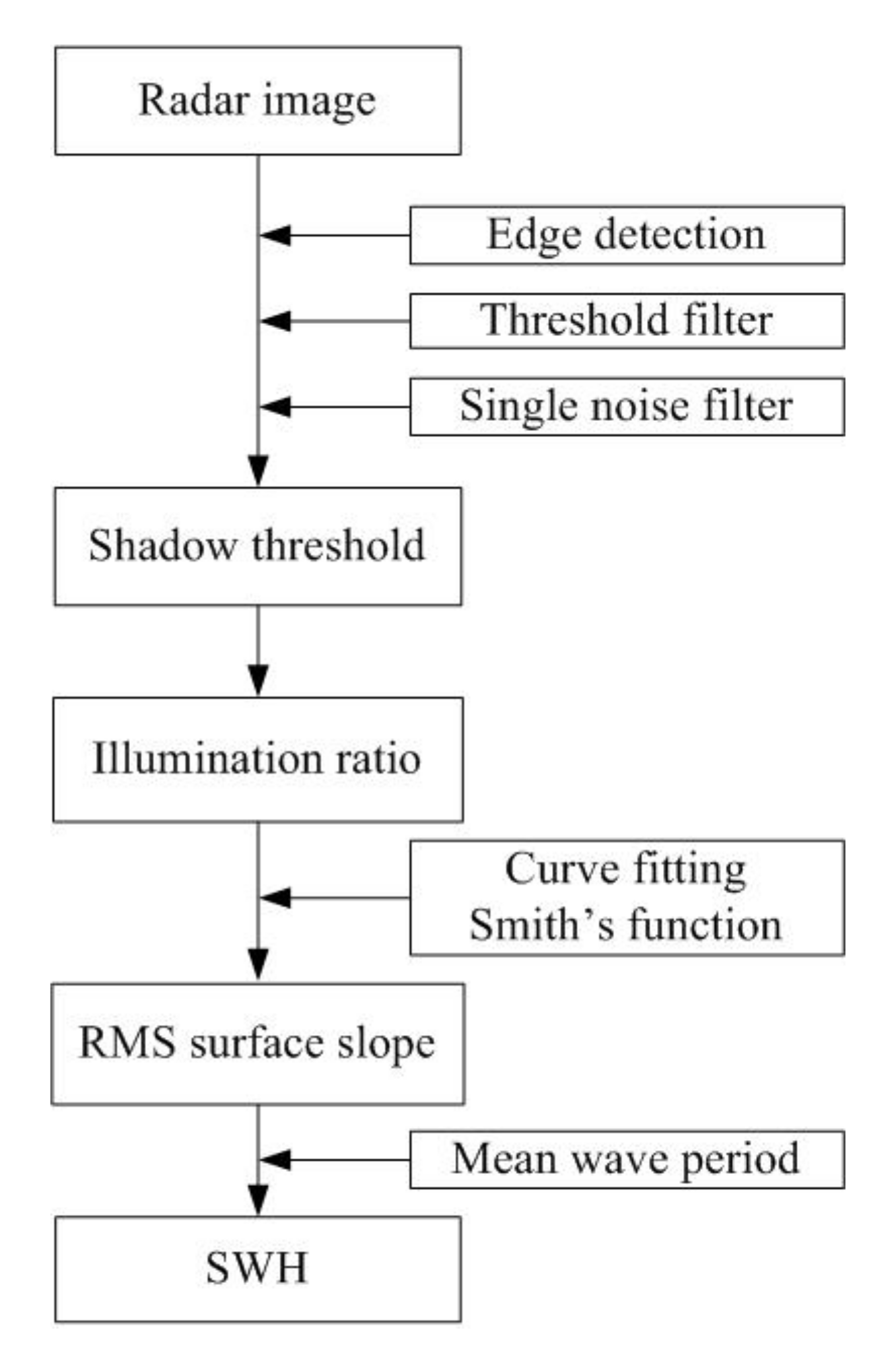
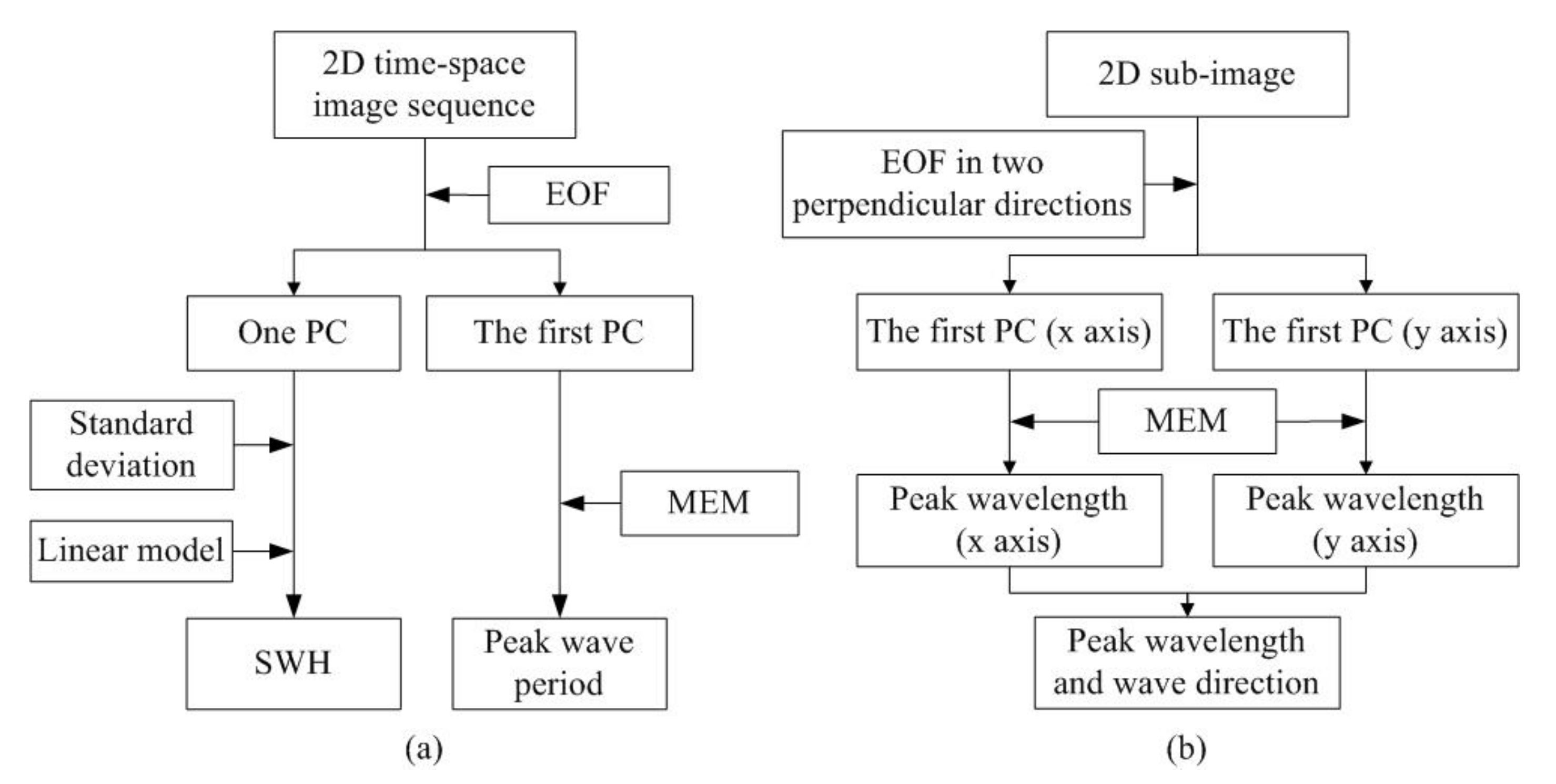
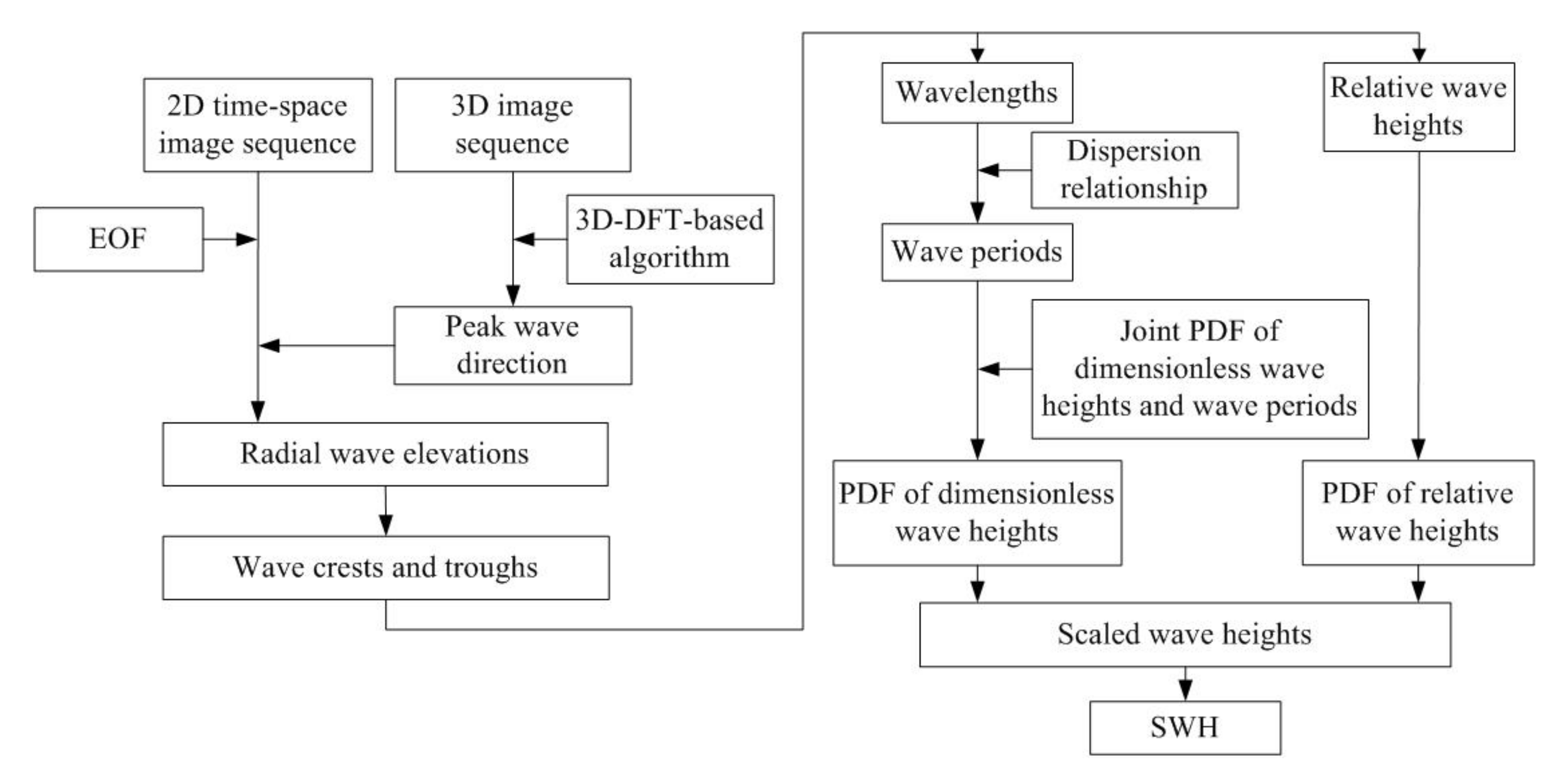
| Methods | Correlation Coefficient | RMS Difference | Wind Speed Range (m/s) | Applicable Under | Calibration-Free | Images Required | |||||
|---|---|---|---|---|---|---|---|---|---|---|---|
| Wind Direction | Wind Speed | Wind Direction () | Wind Speed (m/s) | Ship Motion | Blockage | Rain | Wind Direction | Wind Speed | |||
| Local Gradients Method & Neural Networks | 0.99 | 0.96–0.99 | 12.8–14.2 | 0.42–0.85 | 0–16/0–18 | × | √ | × | √ | × | Multiple |
| Optical Flow Motion | 0.96 | 0.64 | 32.1 | 2.68 | 0–18 | × | √ | × | √ | √ | Multiple |
| Single Curve Fitting | 0.95–0.97 | 0.90–0.91 | 14.2–17.4 | 0.79–0.88 | 0–15/2–17 | √ | √ | × | √ | × | Single |
| Dual Curve Fitting | - | - | 14.9–16.6 | 1.4–1.9 | 2–16 | √ | √ | × | √ | × | Single |
| Two-Model Curve Fitting | - | - | - | 1.7 | 2–16 | √ | √ | √ | - | × | Single |
| Original Intensity Level Selection | - | - | 11–14.3 | 0.6–0.8 | 4–22 | √ | × | × | √ | × | Multiple |
| Modified Intensity Level Selection | - | - | 11.8–16.3 | 1–1.4 | 2–16 | √ | √ | × | √ | × | Multiple |
| Texture-Analysis -Incorporated | - | - | 16.8 | 1.5 | 2–16 | √ | √ | √ | √ | × | Multiple |
| Probability Distribution Function | - | - | 26.2 | 1.37 | 0–20 | √ | √ | × | × | × | Single |
| Background Noise | - | 0.89 | - | 2.86 | 1–10 | √ | × | × | - | × | Multiple |
| 1D Spectral Analysis | - | 0.89 | 15.8 | 1.6 | 2–16 | √ | √ | √ | √ | × | Single |
| 1D/2D Ensemble Empirical Mode Decomposition | 0.98 | - | 11.4–12.7 | - | - | √ | √ | √ | √ | − | Single |
| Ensemble Empirical Mode Decomposition - Normalization | - | - | 11.5 | 1.31 | 2–16 | √ | √ | √ | √ | × | Single |
| Methods | Wave Spectrum Estimation | Wave Height Measurement | Correlation Coefficient of | RMS Difference of (m) | Range of (m) | Calibration - Free | Images Required |
|---|---|---|---|---|---|---|---|
| Traditional 3D DFT | √ | √ | 0.71–0.89 | 0.18–0.42 | 0.5–2/ 1–4/ 0.5–5.5 | × | Multiple |
| Multilayer Perceptrons | √ | √ | 0.96–0.97 | 0.22–0.27 | 0.5–8/ 0.5–10 | × | Multiple |
| Iterative Least-Squares | √ | × | - | - | - | × | Multiple |
| Quadratic Polynomial MTF | √ | × | - | - | - | × | Multiple |
| Variable-Exponent Linear MTF | √ | × | - | - | - | × | Multiple |
| Adaptive Recursive Positioning | √ | × | - | - | - | × | Multiple |
| Geometrics-Based SNR Estimation | √ | √ | 0.89 | 0.19 | 0.5–2 | × | Multiple |
| 2D Continuous Wavelet Transform | √ | √ | - | 0.61 | 2–3.5 | × | Single |
| Array Beamforming | √ | √ | 0.95 | 0.12 | 0.5–2 | × | Multiple |
| Illumination Probability | × | √ | 0.54–0.67 | - | 1–6.5 | × | Single |
| Statistical Analysis | × | √ | 0.65–0.67 | 0.68–0.77 | 0.5–9 | × | Single |
| Tilt-Based | × | √ | 0.94 | 0.35 | 0.5–6 | √ | Multiple |
| Original Shadowing-Based | × | √ | 0.87 | - | 1.5–10.5 | √ | Single |
| Modified Shadowing-Based | × | √ | 0.81 | 0.47 | 1–5 | √ | Single |
| Water-Depth-incorporated | × | √ | 0.68 | 0.51 | 0.5–5 | √ | Single |
| Support Vector Regression | × | √ | - | 0.38–0.82 | 2–6/ 2–9 | √ | Single |
| Empirical Orthogonal Function-Principal Component | × | √ | 0.93 | 0.21 | 0.5–3.5 | × | Multiple |
| Rotated Empirical Orthogonal Function | × | √ | 0.88–0.92 | 0.14–0.17 | 0.5–1.8 | × | Multiple |
| Empirical Orthogonal Function-Joint PDF | × | √ | 0.77–0.78 | 0.51 | 0.2–3.5 | √ | Multiple |
| Ensemble Empirical Mode Decomposition | × | √ | 0.91 | 0.36 | 1–5 | × | Single |
| Coherent radar | √ | √ | 0.98 | 0.15–0.23 | 0–5 | √ | Multiple |
© 2017 by the authors. Licensee MDPI, Basel, Switzerland. This article is an open access article distributed under the terms and conditions of the Creative Commons Attribution (CC BY) license (http://creativecommons.org/licenses/by/4.0/).
Share and Cite
Huang, W.; Liu, X.; Gill, E.W. Ocean Wind and Wave Measurements Using X-Band Marine Radar: A Comprehensive Review. Remote Sens. 2017, 9, 1261. https://doi.org/10.3390/rs9121261
Huang W, Liu X, Gill EW. Ocean Wind and Wave Measurements Using X-Band Marine Radar: A Comprehensive Review. Remote Sensing. 2017; 9(12):1261. https://doi.org/10.3390/rs9121261
Chicago/Turabian StyleHuang, Weimin, Xinlong Liu, and Eric W. Gill. 2017. "Ocean Wind and Wave Measurements Using X-Band Marine Radar: A Comprehensive Review" Remote Sensing 9, no. 12: 1261. https://doi.org/10.3390/rs9121261





